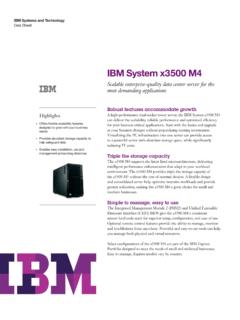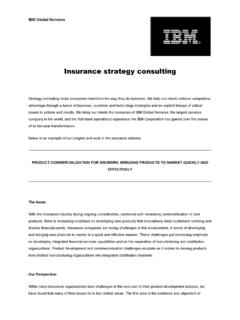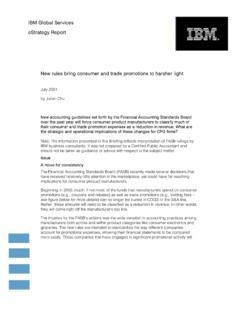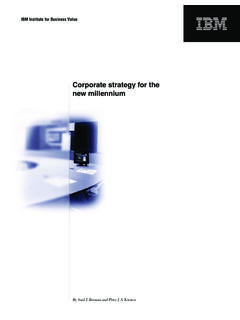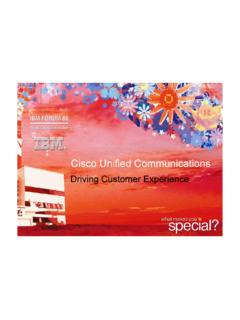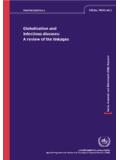Transcription of blended learning lets get beyond the hype - IBM
1 IBM Global Services Consultants point of view By Margaret Driscoll blended learning : Let's Get beyond the hype I spent this summer writing the second edition of my book Web-Based Training. One of the topics that required updating was blended learning . In the four years since the book was published, the term has taken on several new means. In my research I found the term blended learning referred to four different concepts. blend ed learn ing v. 1. To combine or mix modes of web-based technology ( , live virtual classroom, self-paced instruction, collaborative learning , streaming video, audio, and text) to accomplish an educational goal. 2. To combine various pedagogical approaches ( , constructivism, behaviorism, cognitivism) to produce an optimal learning outcome with or with out instructional technology. 3. To combine any form of instructional technology ( , videotape, CD-ROM, web-based training, film) with face-to-face instructor-led training.
2 4. To mix or combine instructional technology with actual job tasks in order to create a harmonious effect of learning and working. The point is blended learning means different things to different people. This may appear to be an academic point but in reality these definitions illustrate the untapped potential of blended learning . Before looking at some different applications of blended learning let's look at why blended learning has been so readily adopted. It is not surprising that blended learning solutions are a great way to initiate an organization into e- learning . Using blended learning benefits the learner, the training staff and the organization's bottom line. blended learning allows organizations to gradually move learners from traditional classrooms to e- learning in small steps making change easier to accept. Working in a blended environment enabled instructors and instructional designers to develop the skills needed for e- learning in small increments.
3 Training professionals can move small sections online as they develop the needed e- learning skills. Cost and resources are also a driving factor. Many organizations have spent a great deal of money developing materials and they are not blended learning : Let's Get beyond the hype about the throw that investment away. blended learning allows them to supplement or compliment existing courseware rather than replace it. Meeting with IBM's Mindspan customers is always educational for me. Here are some of the ways in which people are using blended solutions. The following examples provide concrete examples of one or more of the definitions of blended e- learning . 1. Put the assessment online. One of the easies places to start is to move a test or assessment online. A. financial services organization created a blended solution for a customer service course. They kept their traditional instructor-led, two-day course and put the multiple-choice test online.
4 This allowed the training department to automate scoring and made it easier to track and report scores. 2. Follow up with a community of practice. A technology company teaching their IT staff a new programming language created a threaded discussion for learners to access after training. This threaded discussion allowed learners to stay in touch with classmates and to ask questions, share insights, and post resources. 3. Make reference materials available. A government organization providing training for their support staff provides links to reference materials for learners to use after the training program. The links enabled learners to explore topics in greater depth and reduced their reliance on three ring binders of information which traditionally became outdated in a matter of months. 4. Deliver pre-work online. IBM's own management development program Basic Blue is a great example of pre-work being done online.
5 Managers attending Basic Blue must complete pre-work online before being issued tickets and travel authorization for the face-to-face portion of the program. Online pre-work saves costs associated with shipping material and the ability to track scores ensures learners show up prepared. 5. Provide online office hours. A company that has invested in set of CD-ROM courses to teach a new desktop application uses online office hours to supplement the CD-ROMs. Learners who want to add the human touch can get help from a real person who can answer questions, help learners devise strategies for learning in a self-paced mode, or simply provide moral support. 6. Use mentoring/coaching as a tool. A manufacturer training service engineers in a five-day, face-to-face class uses online coaching as a way to extend the classroom experience. They found learners needed someone to talk to after the class who could help them with problems they encountered in the field.
6 Using a coach, graduates of the face-to-face program were able to ask questions and those questions enabled the coach (classroom instructor) to improve the face-to-face classes. 7. Provide job-aids. A pharmaceutical company delivering an online course for new sales people supports the course with high tech job aids. The course teaches a propriety selling method linking specific strategies with each phase of the sales cycle. After completing the course, learners are issued a personal digital assistant (PDA) to help them organize their sales calls and the PDA provides job aids. These job aids allow 2. blended learning : Let's Get beyond the hype the reps to review the selling strategies and to access short hints from the course. 8. Access experts. After a recent training event in Singapore, IBM Mindspan sales engineers wanted to learn more about the architecture of the products shipping later this year.
7 The people best able to answer questions and explain the architecture were development experts in Cambridge, Massachusetts. As a follow up to the face-to-face class delivered in Singapore, a live virtual classroom program was created providing sales engineers in Asia with access to the developers in Cambridge. The session included application sharing, white boards, and some document sharing. 9. Create a "lifeline". If you have watched "Who Wants to be a Millionaire" you are familiar with the lifeline concept. This concept is not lost on training professional or IBMers. At IBM we have an application called Blue Pages this application is a telephone directory with the added ability find people with the skills you need. You can search for people who are experts in artificial intelligence, the Americans with Disability Act, or translation and international skills for bi-directional languages.
8 This kind of online tool allow our learners to access expertise outside the formal classroom and to get answer quickly from the best sources. 10. Maximize e-mail and messaging. E-mail is probably one of the least appreciated ways of extending blended learning solutions. Use e-mail distribution lists before, during, and after learning events is powerful. Here are some of the ways we have seen customers using e-mail, directly sending learners attachments with new information, pointing learners to additional resources, suggesting advanced classes, and reminding learners of when they need to get re-certified. These are some simple ideas for getting started. I think the real leap forward will be blending learning with work! Given the reality that one must walk before they run - the examples drawn from our customers are powerful starting points for introducing blended learning .
9 Resources The Node's Guide to blended learning : Getting the Most out of Your Classroom < >. blended learning Case Study < >. blended learning : An old friend gets a new name < >. 3.
